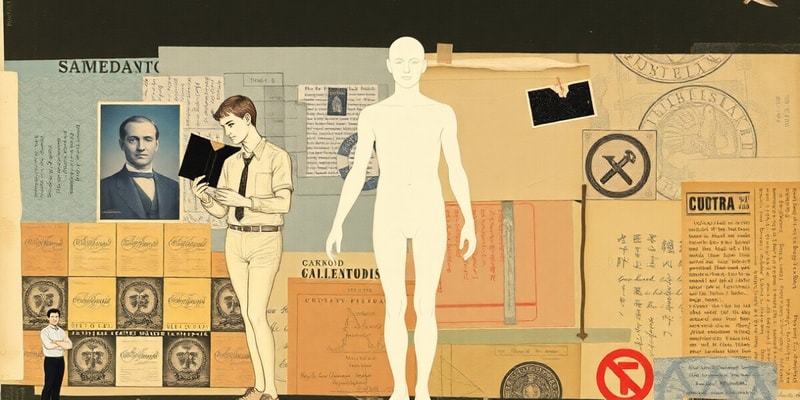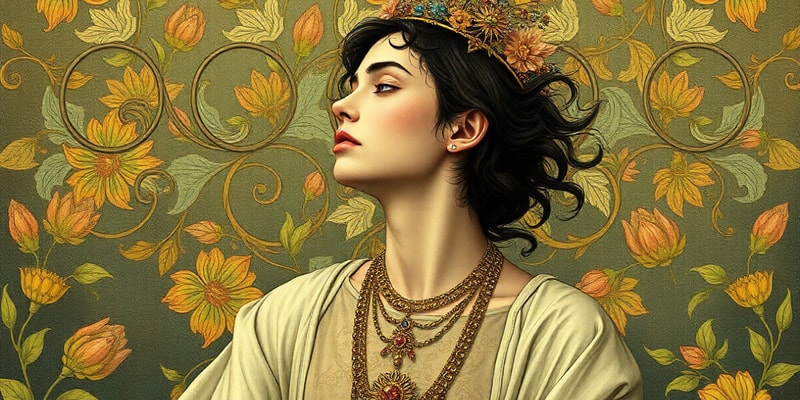Podcast Beta
Questions and Answers
What best describes the physical self?
Which life stage is considered the period from birth to 2 weeks of life?
According to Erik Erikson, what serves as a basis for achieving a sense of competence?
At what age does puberty typically begin for girls?
Signup and view all the answers
What is the primary characteristic of puberty, as described by Santrock?
Signup and view all the answers
What significant physical change occurs in boys during puberty?
Signup and view all the answers
What stage follows late childhood according to the stages of the life span?
Signup and view all the answers
Which statement about growing up is most accurate?
Signup and view all the answers
Which term describes someone who has had one-off sexual encounters that qualify them as bisexual?
Signup and view all the answers
What defining characteristic describes asexuality?
Signup and view all the answers
Which of the following factors significantly influences sexual orientation and gender identity?
Signup and view all the answers
What is a common effect of having a poor body image?
Signup and view all the answers
Which of the following is NOT a cause of poor body image?
Signup and view all the answers
What impact does self-esteem have on an individual?
Signup and view all the answers
Which of the following describes pansexuality?
Signup and view all the answers
Which standard of beauty does NOT typically influence societal expectations?
Signup and view all the answers
Which period of adolescence spans from ages 15 to 17 years old?
Signup and view all the answers
How many pairs of chromosomes are typically found in a human cell?
Signup and view all the answers
What type of chromosome is responsible for determining the sex of an individual?
Signup and view all the answers
What is the main role of genes in physical development?
Signup and view all the answers
Which of the following factors is NOT classified under heredity affecting physical growth?
Signup and view all the answers
What do dominant genes do when present in an individual?
Signup and view all the answers
Which type of bisexual individual primarily has one monogamous relationship at a time?
Signup and view all the answers
Which factor is crucial for physical growth and development after conception?
Signup and view all the answers
Study Notes
Physical Self
- Refers to the body's tangible aspects that can be directly observed and examined.
- Includes basic parts and organs.
Growing Up
- As individuals age, their interests and bodies change rapidly.
- Parents should respect their children's privacy and provide space for them to grow, while also offering support and listening.
Physical Characteristics
- Defining traits or features of a person's body that are distinguished by the naked eye.
- Examples include facial features, hairstyles, clothing, and body shape.
- Erik Erikson believed the body plays a crucial role in early development, as physical and intellectual skills contribute to a sense of competence and ability to navigate life's complexities.
- William James considered the body as the primary source of sensation and essential for personality formation.
Life Span
- Development from conception to death.
Stages of Life Span
- Prenatal - Fertilization to Birth
- Infancy - Birth to 2 weeks of Life
- Babyhood - 2 weeks of Life to second year
- Early Childhood - 2 to 6 years old
- Late Childhood - 6 to 10 years old
- Puberty - 10 or 12-14 years old
- Adolescence - 14 to 18 years old
- Early Adulthood - 18 to 40 years old
- Middle Adulthood - 40-60 years old
- Late Adulthood - 60 years old to death
Puberty
- Defined as a brain-neuroendocrine process that triggers rapid physical changes during early adolescence.
- Usually begins earlier in girls and progresses two to three years later in boys.
- Girls experience menarche (first menstrual flow) and boys experience semenarche (first ejaculation).
Adolescence
- Divided into three periods:
- Early Adolescence (11- 14 years old)
- Middle Adolescence (15- 17 years old)
- Late Adolescence (18-21 years old)
Factors Affecting Physical Growth and Development
Heredity
- Refers to the mechanisms by which characteristics are passed from one generation to the next via genes.
- Genes reside on chromosomes, which are thread-like tissues found in pairs (23 pairs).
- Chromosomes can be categorized as autosomes (22 pairs) or gonosomes (1 pair - X and Y chromosomes).
- Genes encode information for specific proteins, responsible for individual traits.
- Genes can be dominant (strong) or recessive (weak).
- Dominant genes are expressed even if only one allele is present.
- Recessive genes are only expressed if two copies are present.
Environment
- Refers to factors an individual is exposed to after conception, including learning and experience.
- Factors such as diet, nutrition, and diseases play a significant role in physical development.
Sexual Self
- Refers to a person's sexual orientation, gender identity, and their understanding of their own sexuality.
- Asexual: Lack of sexual attraction to others or low interest in sexual activity.
- Pansexual: Attraction to individuals regardless of gender or sex.
- Asexual: Lack of sexual attraction to others, or a low interest in sexual activity.
- Pansexual: Can be attracted to anyone, regardless of their gender or sex.
Factors Influencing Sexual Orientation and Gender Identity:
- Sociocultural Factors
- Southeast Asian countries often view heterosexuality as the norm.
- Family Influence
- Children's upbringing and social environment influence their developing gender identities.
- Urban Setting
- Large cities may offer a more welcoming environment for individuals to develop and express same-gender interests than rural areas.
- History of Sexual Abuse
- Studies suggest that abused adolescents, particularly those victimized by males, might be more likely to identify as homosexual or bisexual in adulthood.
Body Image and Concept of Beauty
- Body Image: Combination of thoughts and feelings individuals have about their bodies.
- Body image can range from positive to negative experiences, and individuals might experience a mix of both at different times.
- Influenced by both internal (personality) and external (social environment) factors.
- Self-esteem: How individuals value and respect themselves as a person; it is the opinion they have of themselves.
- Self-esteem impacts how individuals take care of themselves emotionally, physically, and spiritually.
Causes of Poor Body Image
- Emphasis on the thin ideal body: Societal pressures to conform to a specific body type.
- Bullying and Peer Pressure: Negative interactions and social expectations can impact body image negatively.
- Media: Media representations often contribute to unrealistic beauty standards.
Effects of Poor Body Image
- Body Dissatisfaction: Dissatisfaction with one's body can lead to negative comparisons with others and a distorted perception of oneself.
- Depression: Poor body image can contribute to feelings of sadness, hopelessness, and worthlessness.
- Low Self-esteem: A negative body image can lead to a diminished sense of self-worth and a lack of confidence.
- Eating Disorders: Poor body image can trigger unhealthy eating habits such as bulimia and anorexia nervosa.
- Body Modification: Individuals may attempt to change their physical appearance through various modifications such as tattooing, body piercing, or cosmetic surgery.
Standards of Beauty
- Clean and unblemished skin
- Thick, shiny hair
- Well-proportioned body
- Healthy appearance
Studying That Suits You
Use AI to generate personalized quizzes and flashcards to suit your learning preferences.
Related Documents
Description
Explore the various aspects of physical development from prenatal stages to adulthood. This quiz covers key characteristics, changes during growth, and the influence of physical traits on personality and competence according to theorists like Erikson and James. Test your understanding of how physical attributes shape our lives!




